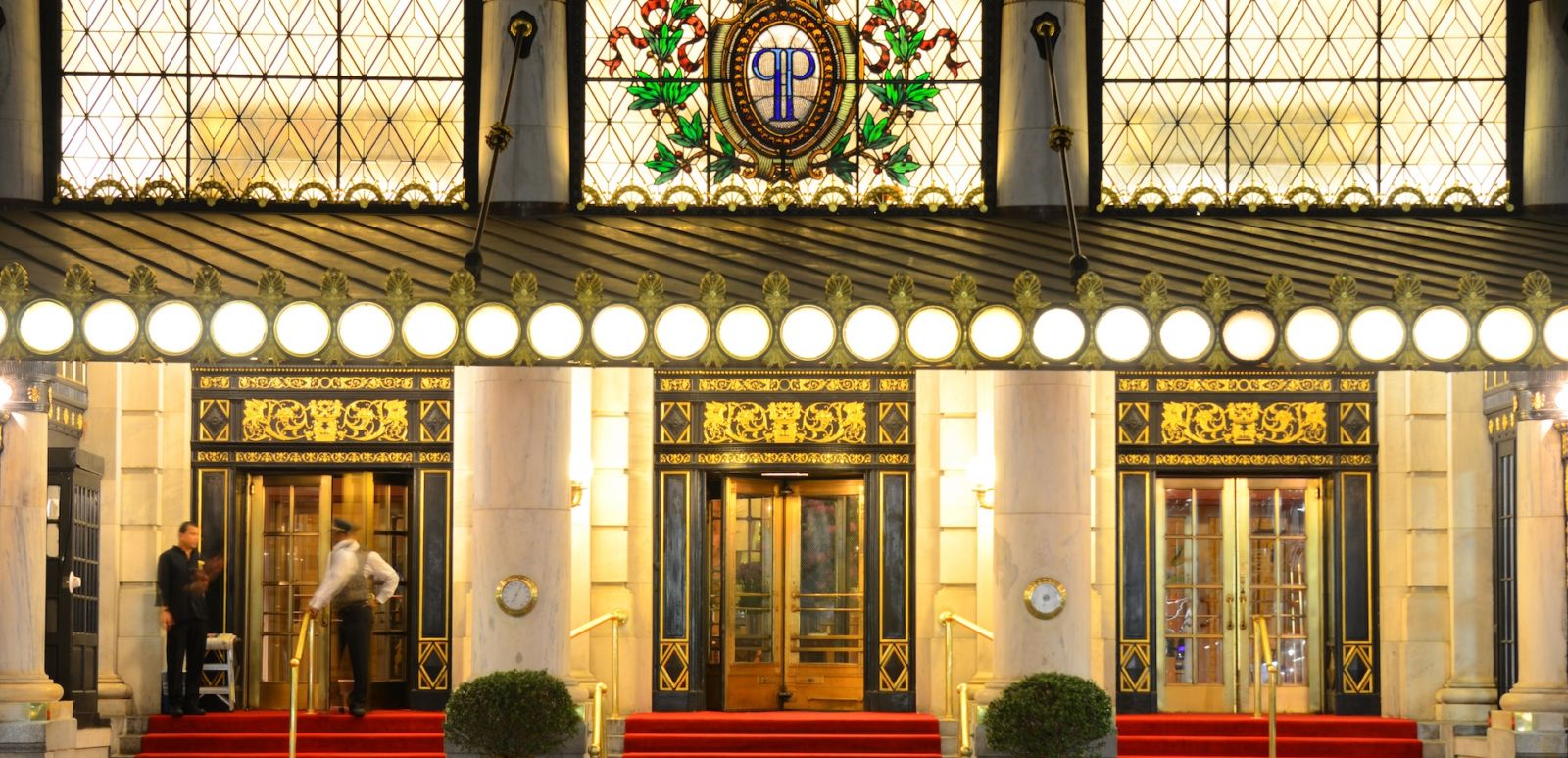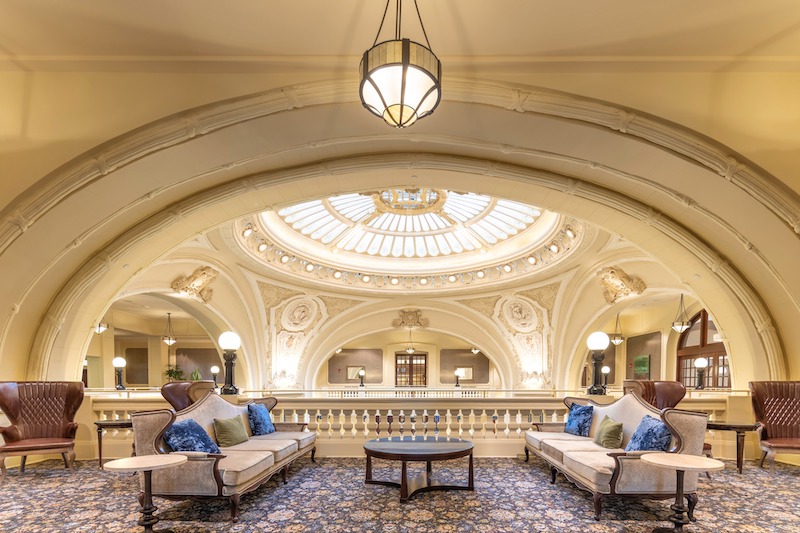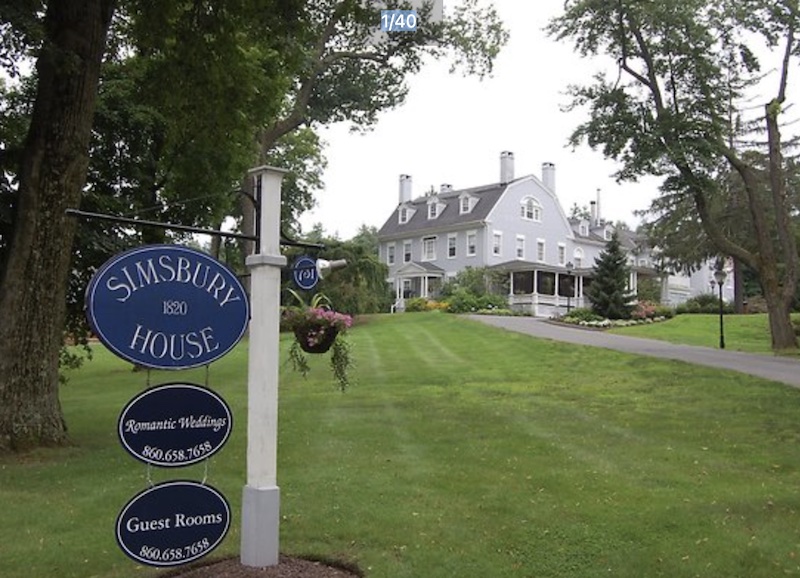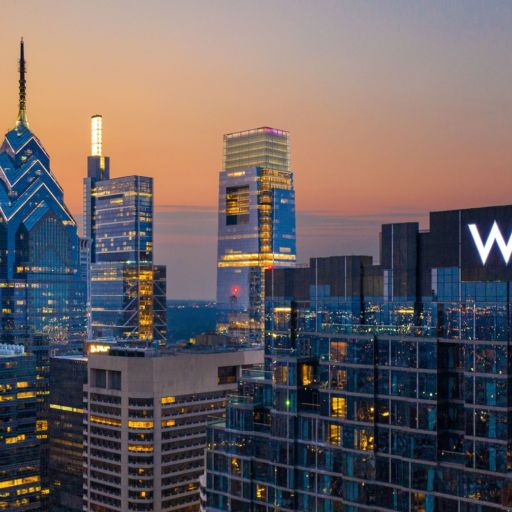In America’s early years, hotels were more like roadside taverns. Travelers posted up in these rustic guest houses for the night and enjoyed a pint of ale before continuing along the road. Somewhere during our history, though, hotels became symbols of civic grandeur; the finer your city, the bigger and fancier its hotels became. Many of those historic showpieces live on today, and stand as some of the most iconic hotels in America. But “iconic” can mean different things in different places, and, as each state has its own past and present character, so does it offer its own definition of an iconic hotel. From Alabama to Wyoming, here is the most iconic hotel in every state.
Alabama – Battle House Renaissance Hotel, Mobile
Opened: 1852 (original)
A prime destination for both vacationers and paranormal fanatics, this 27,000-square-foot hotel has far more to offer than the occasional ghost sighting. During the war of 1812, the Battle House’s grounds served as the headquarters for future president Andrew Jackson. While the original building burned to the ground, James Battle bought the plot of land with his two brothers and built a hotel in 1952. The hotel has since passed through the hands of many owners and, in 2009, became a member of the Historic Hotels of America.
Alaska – The Historic Skagway Inn, Skagway
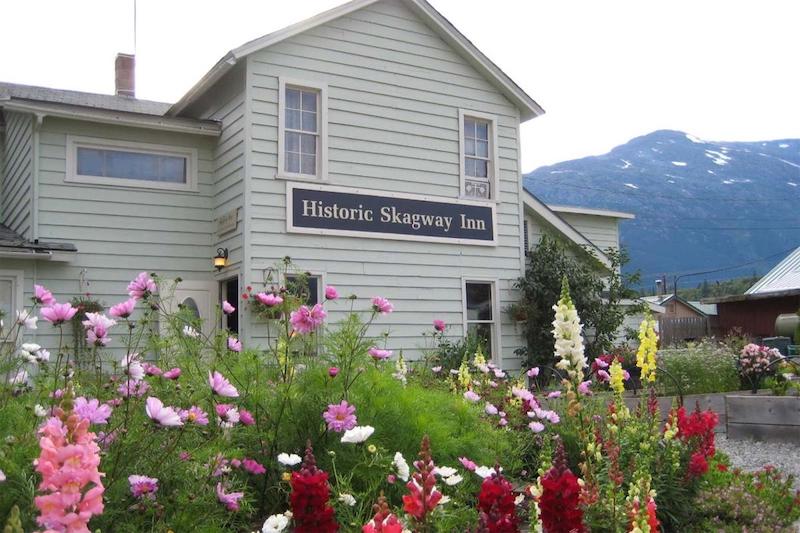
Opened: 1897
Ever want to spend your vacation days experiencing what life in Alaska was like during the Klondike Gold Rush? Probably not, since it involved sleeping in snow and losing most of your money in casinos and brothels. However, you can get a cleaned-up version at the Skagway Inn, a former brothel where each room is named after the women who worked around the property. If beer and hiking are your Alaskan jam, the Inn offers housing-and-transportation packages for guests who want to hike the Chilkoot Trail, which all include an Alaska Amber beer for each hiker to down after the 33-mile journey.
Arizona – Hotel Congress, Tucson
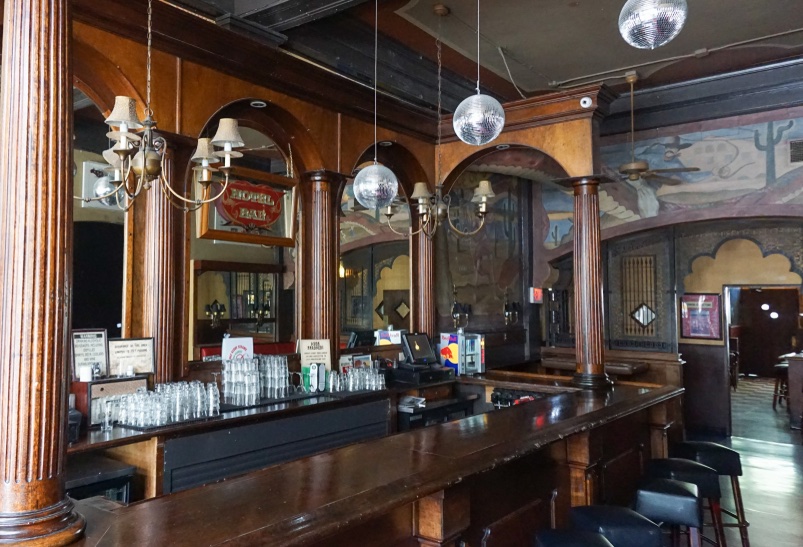
Opened: 1919
Listen, weird things happen out in the desert. Most of the time, people who want strange desert experiences have to head out into the sand to get them, but Hotel Congress brings the seance experience into the, errrr, comfort of a haunted hotel. Literally haunted. This hotel has a “seance experience” and openly advertises its specific ghosts and what rooms they live in. And ghosts aren’t the only relics of a past life here: rooms are equipped with vintage radios and rotary phones, which are connected to a switchboard behind the front desk. With a Tap Room bar, prime access to downtown Tucson, a rock ‘n’ roll attitude and supernatural tenants, it’s no surprise that the hotel doesn’t refund for noise complaints. Join the party, or pick up earplugs at the front desk.
Arkansas – The Crescent Hotel, Eureka Springs
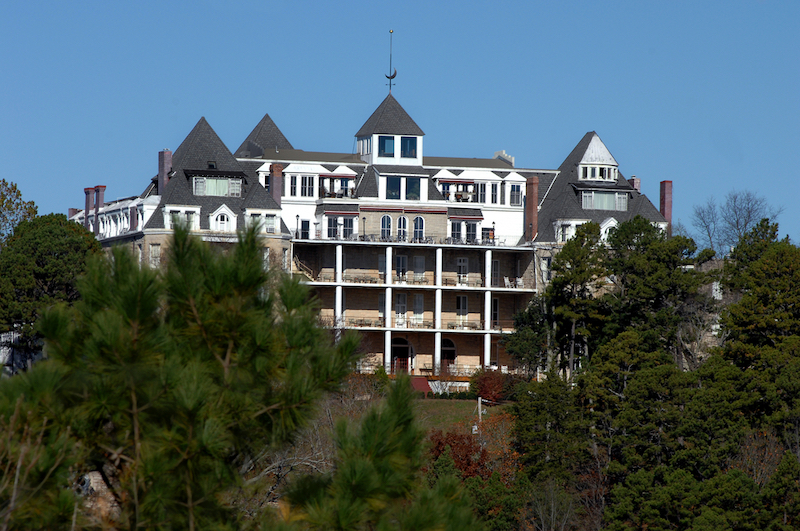
Opened: 1886
We get it: A lot of hotels on this list claim to be haunted, BUT this is the one that’s earned the nickname “America’s Most Haunted Hotel.” The Crescent Hotel really leans into its spooky allure, and its darker history lends to the legend. In the 1930s,the building housed the Baker Hospital, where Norman Baker deceived and treated cancer patients with a false cure. Whether Baker believed he was doing good or was simply taking advantage of his patients, he made around $4 million on his “cure” and was responsible for hundreds of deaths. The hospital was renovated into a hotel and nowy attracts thrill-seekers to its ghost tours and other haunted activities.
California – Hotel Del Coronado, San Diego
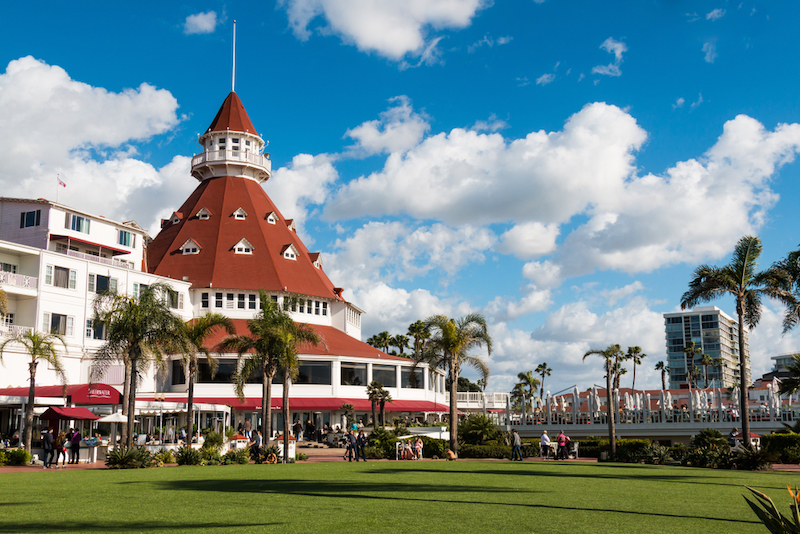
Opened: 1888
From the Hollywood hedonism at Chateau Marmont to the stately white Claremont in Berkeley, California may be second only to New York City in its wealth of iconic hotels, but this San Diego landmark rises above the rest. It couldn’t be more California coast if it tried, standing tall with Victorian poise and overlooking white sandy beaches. The Del, as it was nicknamed, sent a shockwave through the nation upon its opening because it was believed to be one of the largest buildings with full electricity at the time. Over the years, the hotel has hosted notable guests such as President William Taft and author L. Frank Baum, who wrote the “Wizard of Oz,” and is allegedly still home to the ghost of a mysterious young woman who checked in in 1892 but never checked out.
Colorado – The Stanley Hotel, Estes Park
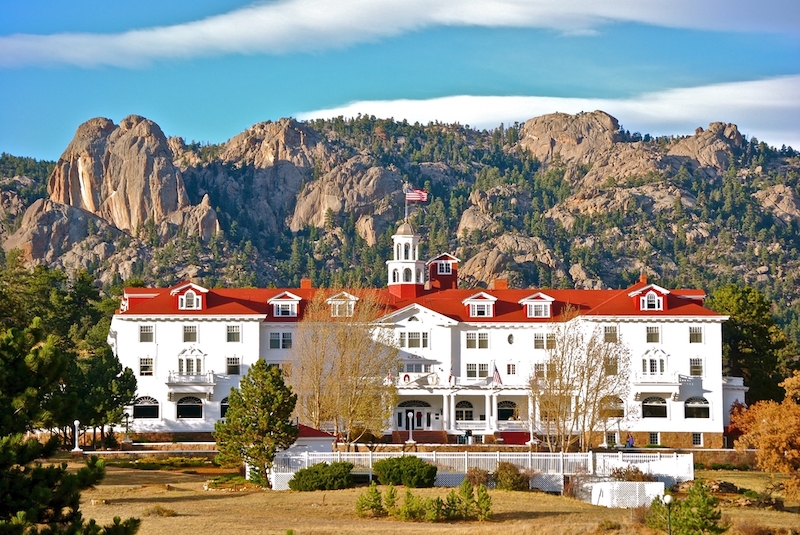
Opened: 1909
We all know Stephen King wasn’t a fan of the film adaptation of his book “The Shining,” which was filmed at The Stanley Hotel, but a nightmare during his stay here did inspire the novel. While you most likely won’t be greeted by Jack Torrance or the ghostly bartender Lloyd at the hotel’s Whiskey Bar, the 420-room establishment has more to offer than nods to the film and “the Shining Ball.” Prime access to Rocky Mountain National Park makes hiking, mountain biking and other very Colorado outdoor activities a hotel staple. Enjoy the fresh mountain air, but don’t play with creepy twins.
Connecticut – Simsbury 1820 House, Simsbury
Opened: 1985
Once owned by Revolutionary War hero Noah Phelps, this hotel’s home has served a number of purposes since it was first built by Phelps’s son Elijah. Banker Amos R. Eno and his wife, Lucy Jane Phelps, purchased the property to use as a summer home. The two made many additions to the house, and it remained a family residence before becoming a restaurant in the late 1940s. It was later purchased by Simsbury House Associates and restored into the 32-room Simsbury 1820 House it is today. The building’s location in downtown historic Simsbury provides access to such riveting attractions as the Simsbury Cemetery—if you’re into tombstones from 1688.
Delaware – Hotel Du Pont, Wilmington
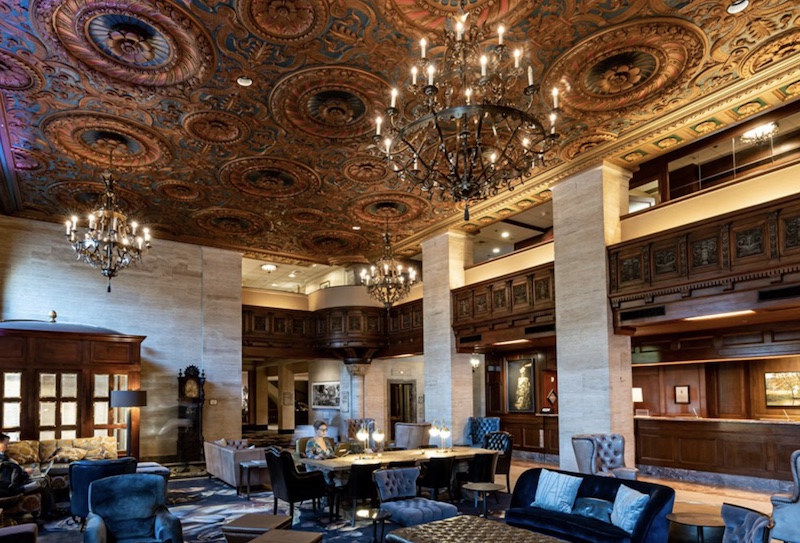
Opened: 1913
Pierre S. du Pont, American entrepreneur and heir to the du Pont family fortune, commissioned the construction of the DuPont Building in the first decade of the 20th century. It originally spanned the length of a city block and housed the DuPont headquarters. However, Hotel Du Pont didn’t come into existence until the early 1910s when a massive expansion of the building and renovation of the original structure birthed the elegant marble floors and decadent artisanal ceilings that have since seen famous guests such as Prince Rainier of Monaco and Amelia Earhart. When the workers finally packed up their hammers, the building took up an entire block. Another renovation in 1991 elevated the already lavish space by converting the original 295 rooms into 217 larger rooms for guests to enjoy—a $40 million project that put the hotel back on the map.
District of Columbia – Willard InterContinental Hotel
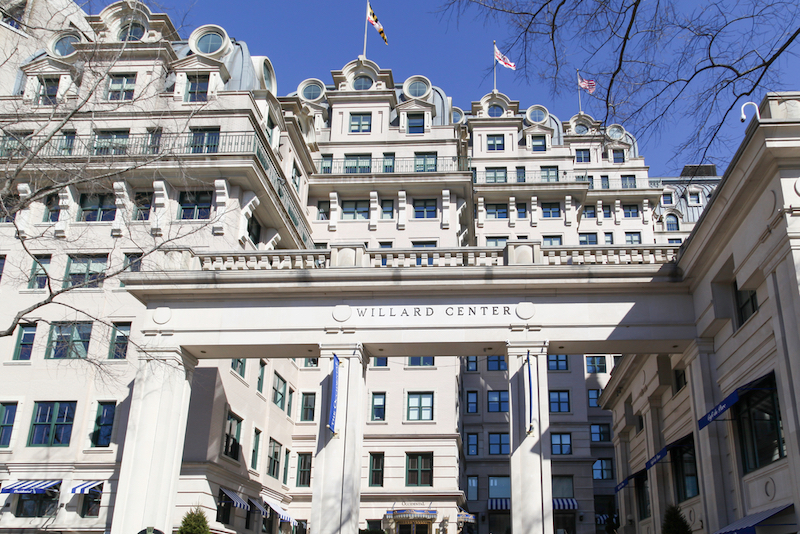
Opened: 1817 (original), (1901 today)
Planted right in the heart of American politics, every U.S. president since 1850 has either visited or stayed at some iteration of D.C.’s Willard InterContinental Hotel. The hotel’s origins can be traced back to 1817 when a group of small interconnected row houses was built on the property before Henry Willard bought the land in 1847. Willard demolished the previous structure and built a four-story hotel of his own, where—in true political fashion—a waiter was killed by a congressman in 1856 during a dispute over serving times for breakfast. The building was once again torn down in 1901, and the 12-story behemoth of today took its place.
Florida – The Breakers, Palm Beach
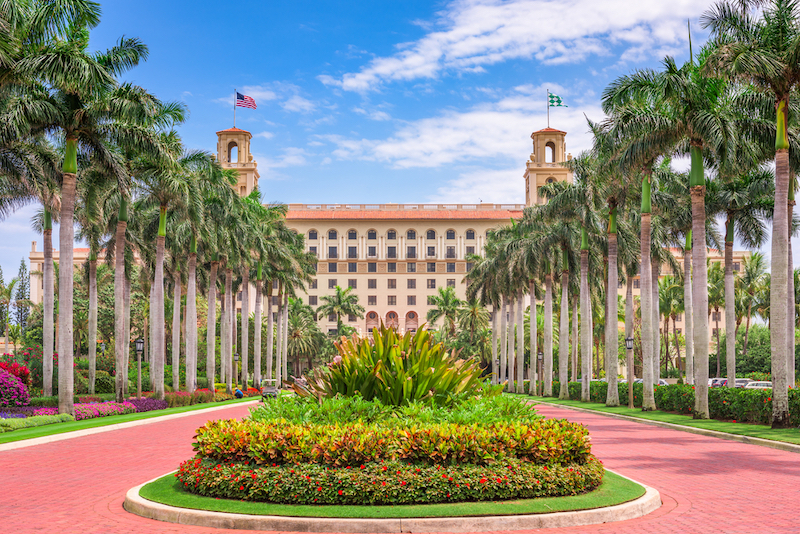
Opened: 1896 (The Palm Beach Inn, Original Breakers), 1926 (hotel of today)
Standard Oil co-founder Henry Flagler spent the second act of his life building a vacation paradise in Florida, drawing wealthy northern tourists down south with opulent hotels. The only one still operating as a hotel is The Breakers, which originally opened in 1896 as The Palm Beach Inn. After a huge renovation and addition to the hotel, it was renamed The Breakers as a nod to guest requests for rooms by the waves. Unfortunately, the original building burned to the ground in 1903, but that didn’t deter Flagler. He rebuilt the hotel in time to open for the 1904 season. Unfortunately, the hotel suffered another devastating fire in 1925. This time, the Florida East Coast Hotel Co. reconstructed the hotel with inspiration from Villa Medici, resulting in the alluring seven-story building of today.
Georgia – Jekyll Island Club, Jekyll Island
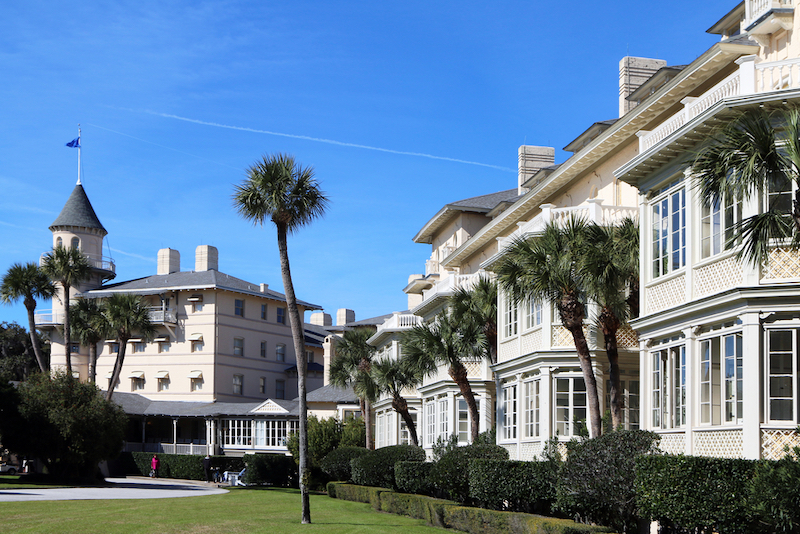
Opened: 1888
The Jekyll Island Club looks like the kind of place you’d see hosting midsummers parties on “Outer Banks.” That’s because the kooky hideaway was a Gilded Age winter escape for America’s upper class until the party came to a screeching halt during the Great Depression. Waning resources and an evacuation of the island during WWII left the club abandoned. While Jekyll Island opened to the public as a state park in 1948, the hotel wouldn’t see renovation until it was purchased in 1985. The restored building debuted as a hotel in 1987, and remains a luxurious escape and wedding destination for the Southern Living set.
Hawaii – The Royal Hawaiian, Honolulu
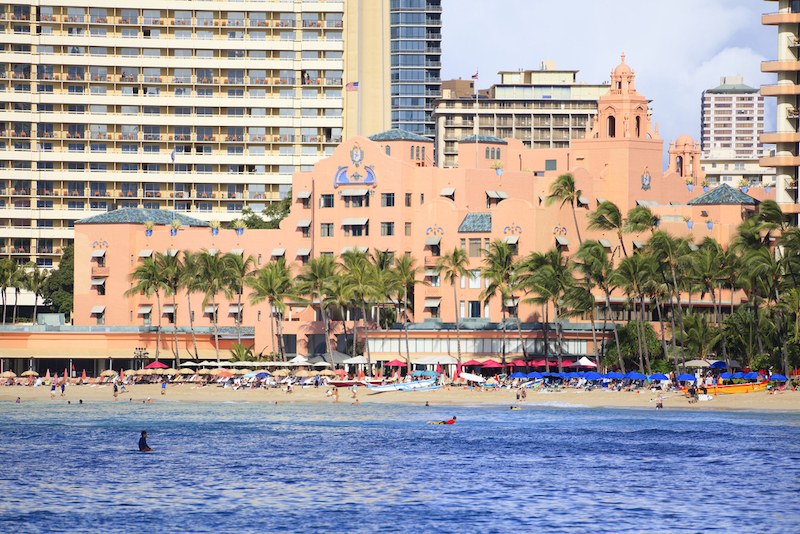
Opened: 1927
The “Pink Palace of the Pacific” opened in 1927 as an ambitious $4 million project built on 15 acres of prime beachfront property. At one point during WWII, the U.S. Navy leased the hotel to use as an R&R center. While the hotel returned to a beachfront paradise for tourists in 1947, the 4.5-day-long boat trip from the upper 48 discouraged tourists from visiting. After air travel made the destination more accessible, the Sheraton Co. picked up the property and it flourished.
Idaho – Sun Valley Lodge, Sun Valley
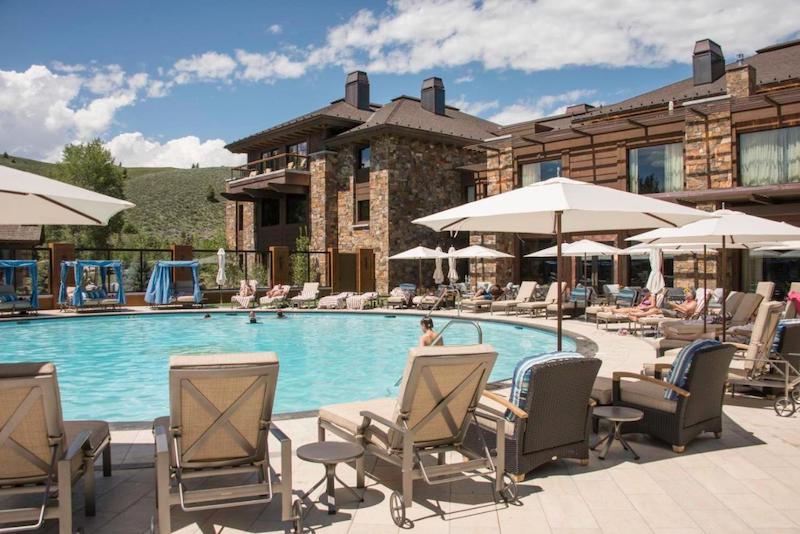
Opened: 1936
Fun fact to tell strangers during the awkward silence on your next chairlift ride: The first ski resort to open a full-service chairlift was Sun Valley in 1936. It was also among the first hotels built specifically at a ski resort, effectively birthing the notion of a ski vacation. Today, the old spot holds up pretty well, adding snowshoeing and Nordic skiing trails, and a surrounding village with amenities like an ice-skating rink and bowling alley. The 108-room lodge also has a spa, glass-enclosed pool and pool café perfect for après.
Illinois – Palmer House, Chicago
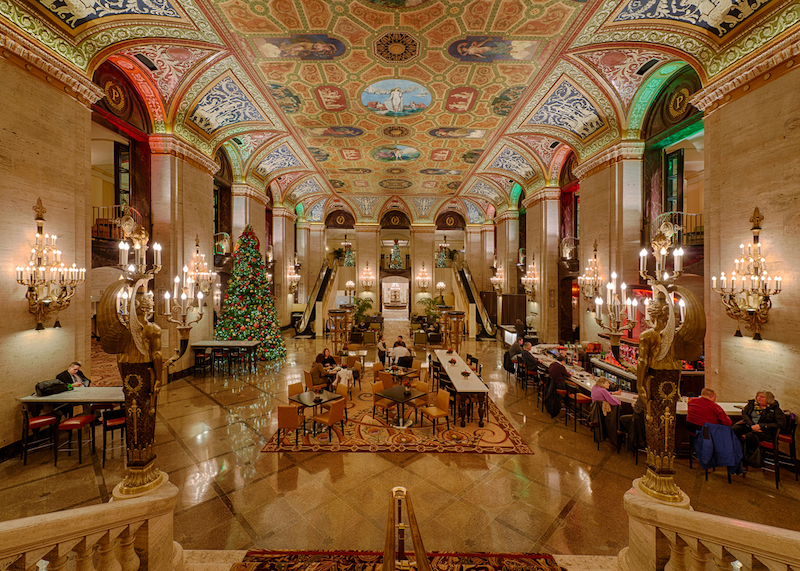
Opened: 1871
Some guys go over the top for their fiancées with engagement gifts. Potter Palmer did that and then some. When he got engaged, he gifted his fiancée Bertha an entire hotel. Sadly, 13 days after the opening of the Palmer House, the hotel burned to the ground in the Great Chicago Fire. (Pro tip, Potter: Shoes would have lasted longer.) Not dissuaded, Palmer scored a $1.7 million dollar loan to rebuild the hotel, and the Palmer House reopened in 1873. The renovation of the Empire Dining Room in 1933 brought popular entertainers like Frank Sinatra and Ella Fitzgerald into the space, and a more recent $170 million renovation raised the profile of this already stunning property.
Indiana – French Lick Resort, French Lick
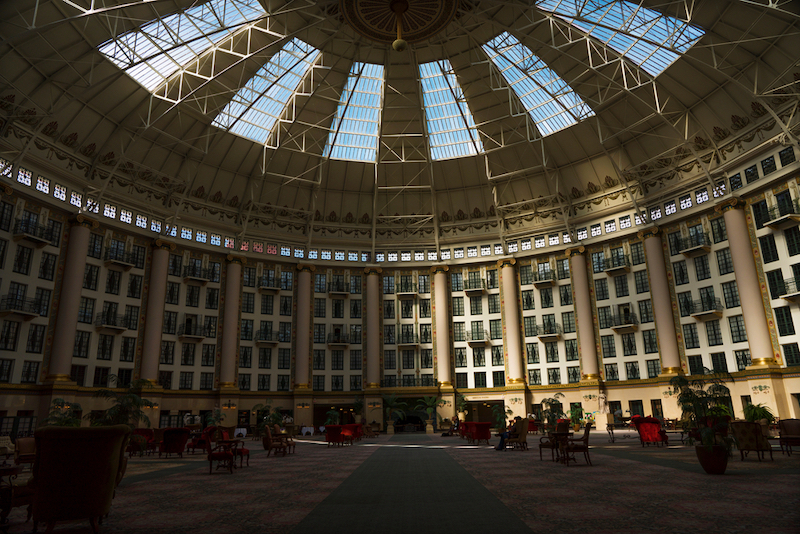
Opened: 1845
Long before “the Hick from French Lick” hipped the basketball-loving world to the existence of this southern Indiana city, natural sulfur springs attracted guests from far and wide. To properly capitalize on the springs’ visitors, Dr. William Bowles built this then-modest resort in 1845. He later sold it to Indianapolis Mayor Tom Taggart, who expanded the property, adding two large golf courses that hosted the PGA Championship in 1924. Over the years, the French Lick hotel fell on hard times, but reopened in 2006 with a brand-new casino within the building.
Iowa – Hotel Julien, Dubuque
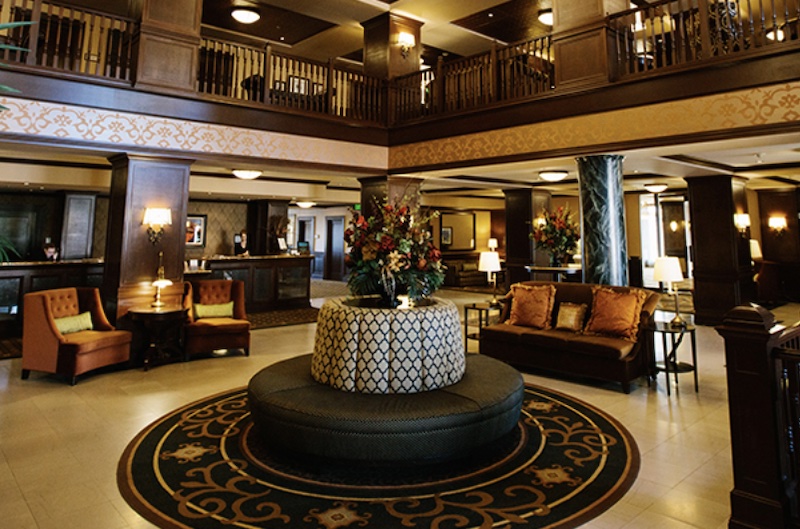
Opened: 1839
The Julien has been an icon since long before hotels used the word “iconic” to describe properties that opened two weeks ago. When pioneers ventured west in the early 1800s, this hotel sticking out of the landscape signaled to travelers that they were close to crossing the Mississippi River, unofficially entering the American West. This old hotel, once called the Waples House, hosted some of history’s most famous names, from Abraham Lincoln and Buffalo Bill, all the way to Al Capone. Today, it’s a brick landmark with an interior that looks like it could have been taken from the Titanic. Though it doesn’t see near the type of traveler it did over 150 years ago, it’s still a welcomed resting spot on a long cross-country journey.
Kansas – Drury Plaza Broadview, Wichita
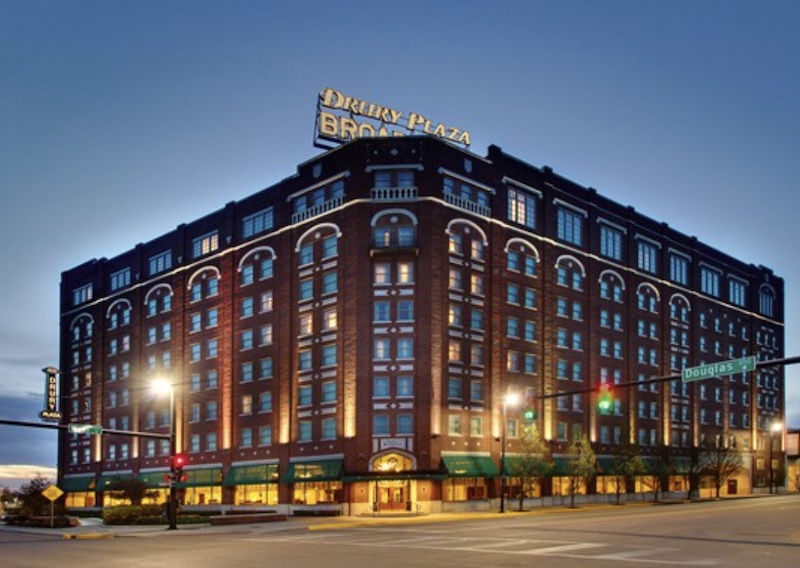
Opened: 1922
It’s hard to imagine remodeling a space as small as your kitchen in only eight months. But, back in 1921 when labor laws and building safety codes weren’t really a thing, this landmark shot up in roughly the length of a hockey season. It sat right along major rail lines and soon became one of the most famous hotels in the Midwest, upping its notoriety considerably during Prohibition when its basement doubled as a 600-seat speakeasy. Today, the big brick behemoth is managed by the Drury Plaza of roadside hotel fame, though their 2011 renovation maintained the original crystal chandeliers and lobby decorations. It also helped restore the 1,500-square-foot mosaic from Native American artist Blackbear Bosin, titled “The Advance of Civilization in Kansas.”
Kentucky – Galt House, Louisville
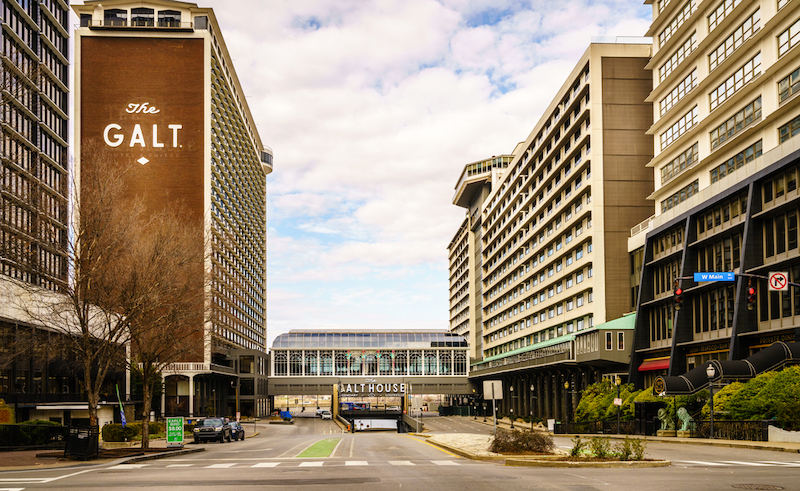
Opened: 1835 (original), 1972 (current)
The newest iteration of the Galt House might not have the unbroken history of The Brown Hotel and its namesake sandwich. Yet, for decades now, the twin towers along the Ohio River have been a symbol of the Louisville skyline.When it comes to pure recognizability, no hotel in Kentucky comes close. During the Kentucky Derby, the hotel’s fabled Silks Bar hosts some of the week’s biggest parties, and you’ll find famous jockeys, trainers and owners posted up here or at Jeff Ruby’s famous steakhouse downstairs. The Galt House also has a massive rooftop gym, with some of the best workout views around.
Louisiana – Hotel Monteleone, New Orleans
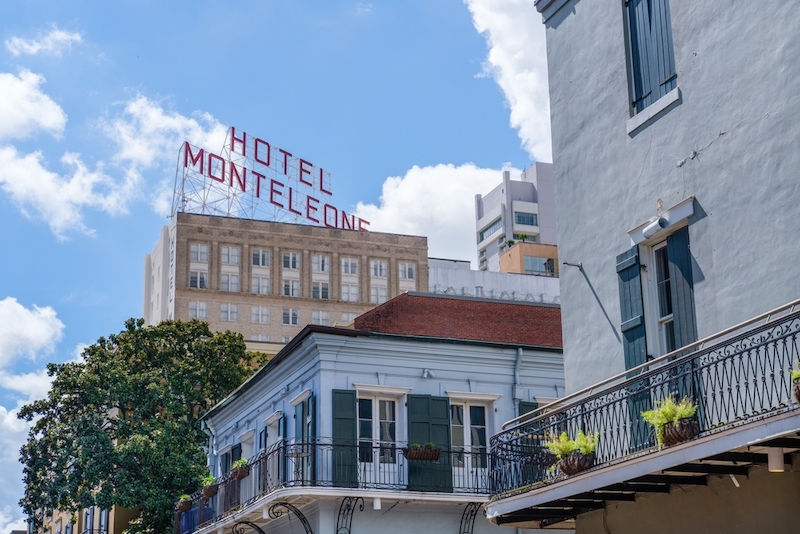
Opened: 1886
New Orleans’ French Quarter is essentially one giant iconic hotel, with so many stunning, historic properties to choose from. If you do have to pick just one, you might as well go with the one whose lobby includes a carousel bar, right? That would be the Monteleone, whose 26-seat revolving bar is far more famous than anything inside its rooms (other than, perhaps, its resident ghosts). It was a favorite haunt of legendary writers like Hemingway, Faulkner and Truman Capote back in the day, which may speak less to the hotel’s grandeur than to the potency of its drinks.
Maine – Colony, Kennebunkport
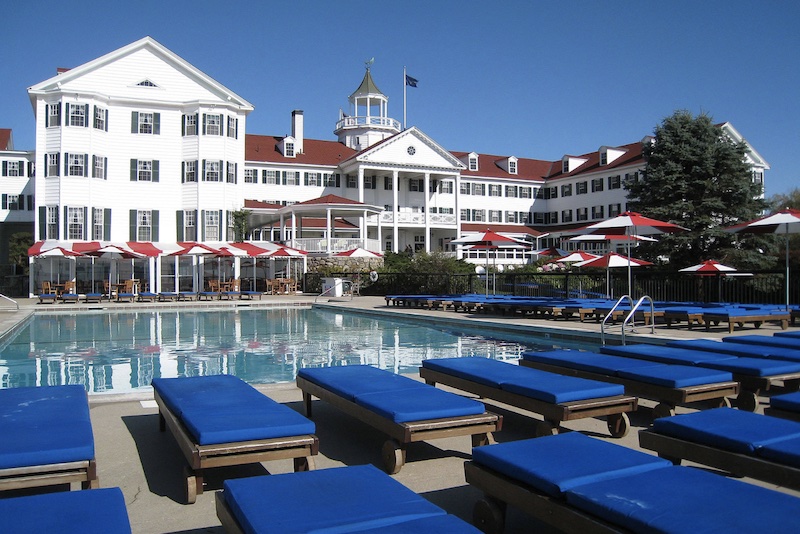
Opened: 1914
This classic white-walled and red-roofed summer escape on the coast of Maine sits on a bluff above the mouth of the Kennebunk River where the water pours out into the Atlantic. The seaside resort was originally a sister hotel with the Colony in Delray Beach, Fla. Though the partnership no longer exists, the early-20th-century opulence remains. Stroll the lobby and hallways filled with period antiques, or opt for dinner in the Grand Dining room, the sort of old-school space that has inspired a thousand cruise ship dinner halls.
Maryland – Inn at Perry Cabin, St. Michaels
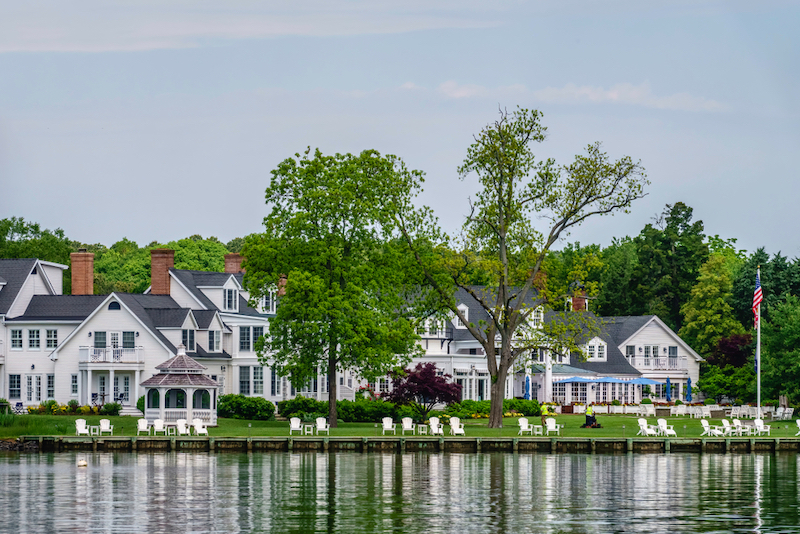
Opened: 1816
A true icon lasts for generations, and no beloved hotel in the Old Line State can claim longevity quite like the Inn at Perry Cabin. In a previous era, this sprawling estate was home to the family behind the fashion brand Laura Ashley. However, most people under 40 know it as the place where Vince Vaughan and Owen Wilson spent extended time as uninvited guests in “Wedding Crashers.” Even if you’re not here for a wedding (invited or not), the hotel is a magical waterside escape, where you can take daylong sailing excursions, then decompress at the spa before enjoying crab cakes in white-tablecloth luxury.
Massachusetts – Omni Parker House, Boston
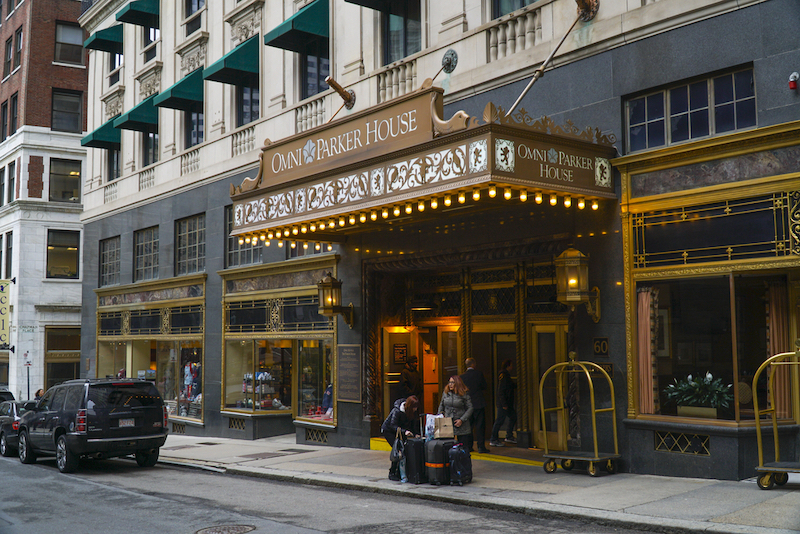
Opened: 1855
If the walls at the Parker House could talk, they’d probably ruin many people’s idea of Camelot: The hotel accommodated the bachelor party for John F. Kennedy. Though no one is sure what happened at the birthplace of the Boston cream pie on that fateful night, it contributes to the hotel’s lore in much the same way as Charles Dickens’s first reading of “A Christmas Carol,” which he gave here, or Malcolm X’s brief stint as a busboy in the hotel’s restaurant. It’s the oldest continuously operating hotel in America, which is probably why there’s an entire book written about the place, “Heaven, by Hotel Standards” by Susan Carolyn Relyea Wilson. If you’ve ever enjoyed a Parker House roll before a big steak dinner, you probably guessed they started here too.
Michigan – Grand Hotel, Mackinac Island
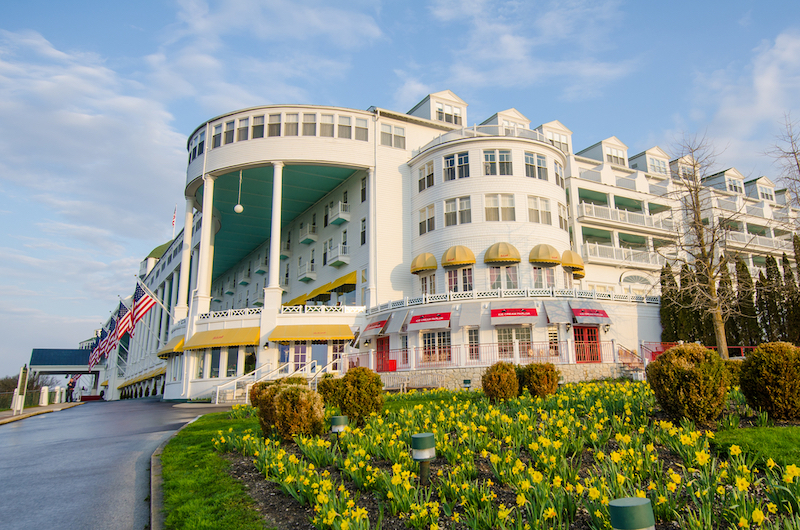
Opened: 1887
The Grand Hotel isn’t just the most iconic hotel in Michigan, it may well be the great American icon of hotels from its bygone era. The meticulously preserved 386-room legend is an island getaway between Great Lakes. For decades, people have gathered on its covered porch, the longest one in the world, to enjoy sunsets and soft-serve ice cream. A trip here truly is a step back in time, not only because the island doesn’t allow cars, but also because traditions like evening dancing downstairs and tuxedoed dinner servers still live on. The hotel has hosted five U.S. presidents and was the setting for 1980’s “Somewhere in Time.” If you stay during the fall, be sure to take the horse-drawn carriage ride to the Woods Restaurant, a chalet-style dinner experience tucked deep in the island forest.
Minnesota – St. Paul Hotel, St. Paul
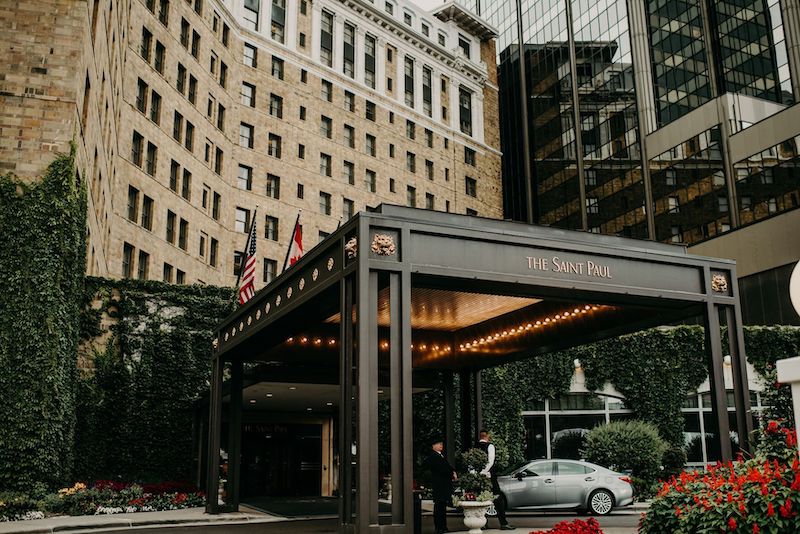
Opened: 1878
Minnesota’s most storied hotel began as a guest house from perennial Midwestern host John Summers, whose Windsor Hotel was dubbed “St. Paul’s Million-Dollar Hotel.” Over the years the grand old building has played major parts in history, whether as the headquarters for St. Paul mob boss Leon Gleckman or as one of Lawrence Welk’s first performance venues. It nearly met the wrecking ball in the 1970s as urban flight sent people to the suburbs and owners gave up trying to restore the place. Luckily, in the 1980s, local business leaders realized how important it was to maintain such a civic icon. It underwent great rehabilitation over the next decade or so, and today remains one of the most sought-after hotels in the state.
Mississippi – White House, Biloxi
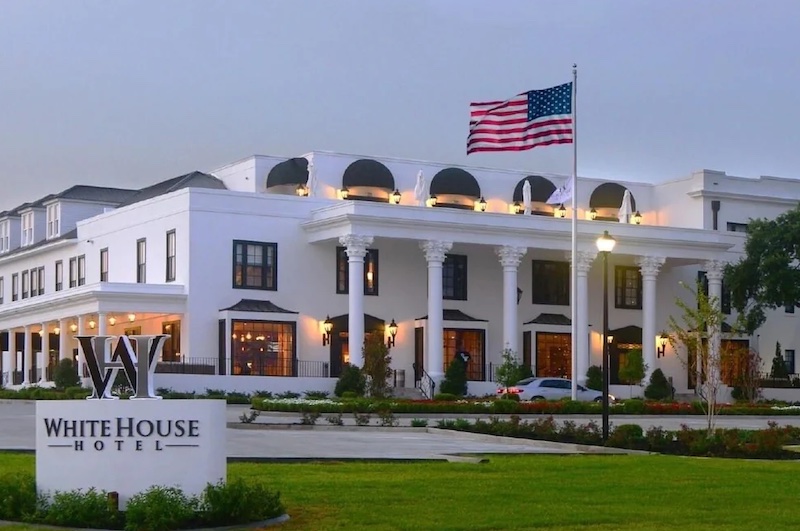
Opened: 1890s
Tired of freeloading relatives and friends drawn to the Mississippi Gulf Coast for its white sandy beaches, Cora White began charging guests who came to her stately home during the 1890s. Her enterprise soon overtook a series of neighboring Victorian homes, and, by the 1910s, the White House hotel was born. Seven live oak trees dotted the gulf-side property, and it became the beach destination of choice in what was then the American Riviera. Though the hotel is named for Cora and her husband Walter White (not that one), the current iteration also resembles another White House in Washington. The building sat in disrepair for over 30 years and even survived Hurricane Katrina in 2005 before reopening in its former glory in 2014.
Missouri – Hotel Kansas City, Kansas City
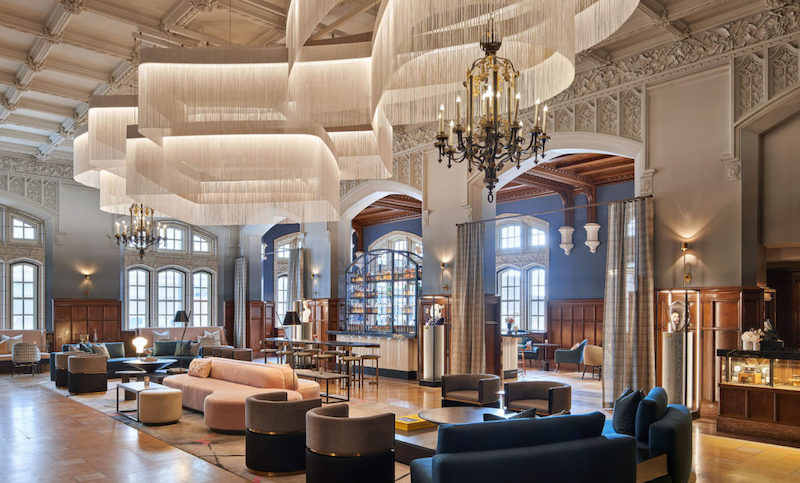
Opened: 1922
The Kansas City Social Club called this 15-story neo-classical beauty home beginning in 1922, when the building included everything from hardball courts to a 14th-floor swimming pool. Prominent club members included Dwight Eisenhower, Harry Truman and Ewing Kauffman, who would meet in the stately ballrooms and stay in one of the club’s 160 rooms. The club moved out in 2002; today, it houses KC’s coolest live music venue in its downstairs speakeasy, Nighthawk, and has a fantastic first-floor restaurant at The Town Co. Look closely and you’ll still find plenty of nods to its history throughout, including some rooms built into the tiles of the old swimming pool, and intricate ceilings in the two-story Tudor ballroom.
Montana – Grand Union Hotel, Ft. Benton
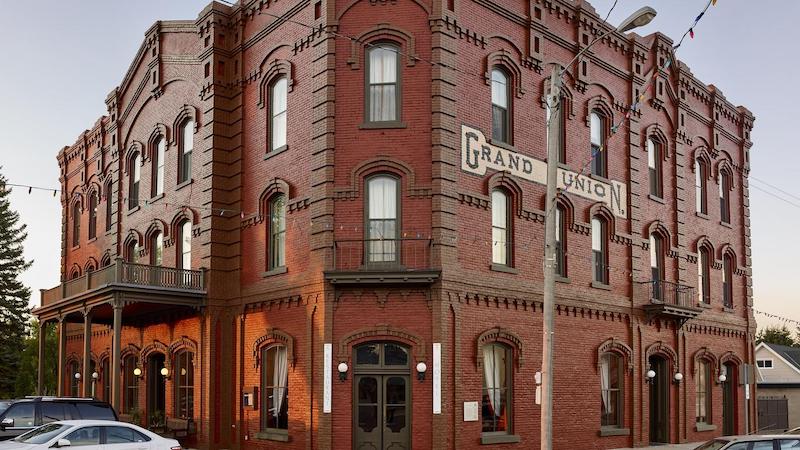
Opened: 1882
This hotel on the Upper Missouri River is actually older than the state of Montana, opening its doors a full seven years before Montana gained statehood. The oldest hotel in Big Sky Country was once a grand respite during the golden age of steamships, a luxurious three-story gem with $150,000 worth of furniture inside. Railroads brought a quick end to Ft. Benton’s place as a transit hub, and, over the next 60 years, the Grand Union saw itself fall further and further into decline. It finally got a facelift when new owners took over in the 1970s. Since, it’s been consistently updated and maintained with décor befitting of its Gilded Age elegance. Its Union Grille is also one of the state’s top eateries, serving hearty, farm-to-table fare on the ground floor.
Nebraska – Hotel Deco, Omaha
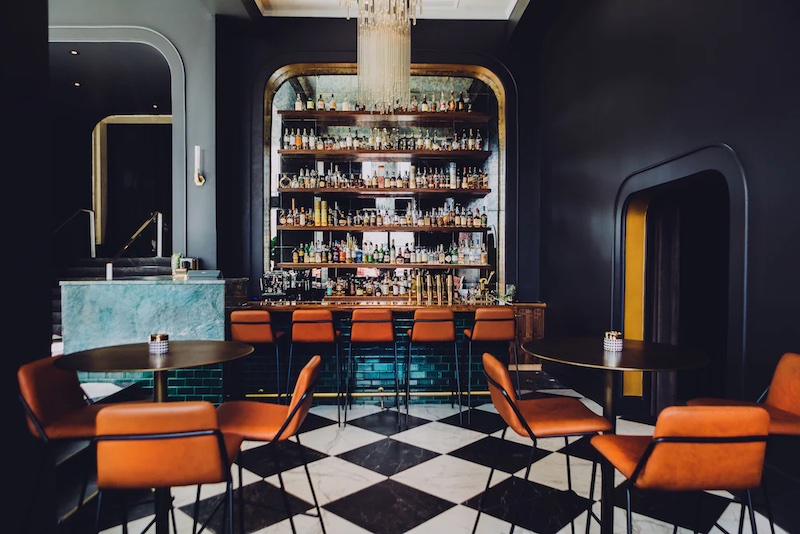
Opened: 1989
Omaha isn’t exactly Miami Beach on the prairie, but its downtown does have a surprisingly robust collection of Art Deco architecture. The best example is this former office building converted into a hotel in 1989. It’s one of only a handful of AAA Four-Diamond properties in all of Nebraska. While the space is decidedly modern for a hotel labeled “iconic,” its seamless fusion of mid-mod design and modern art makes it a true treasure.
Nevada – Caesar’s Palace, Las Vegas
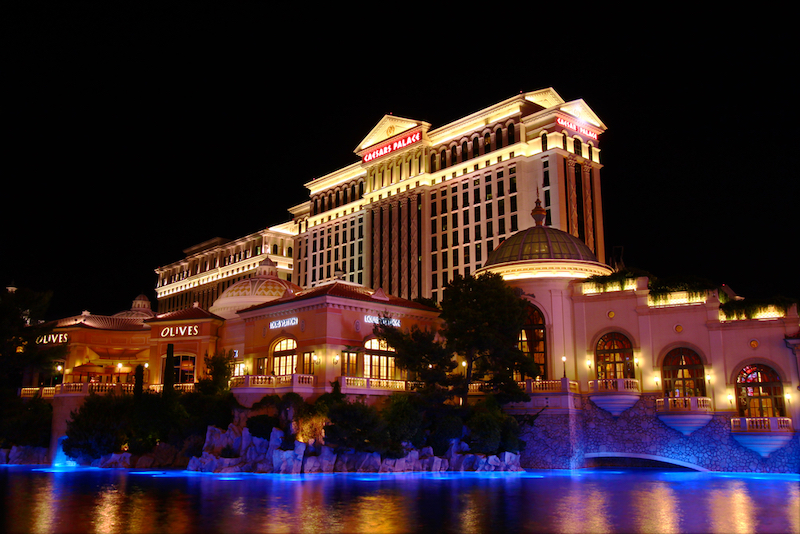
Opened: 1966
Almost any hotel along the Vegas Strip could be considered an icon, whether you’re looking at the faux Eiffel tower at the Paris or the famous water shows at the Bellagio. Nonetheless, no hotel has more of what makes Vegas, Vegas than Caesar’s Palace. Here, Frank Sinatra played, Evil Knievel jumped and every boxer worth his weight had a title fight. It gained notoriety with a whole new generation when the Wolfpack blacked out here and retraced their steps during “The Hangover.” And no one visits Vegas without spending a day under the artificial sky and among the Roman-style palazzo of The Forum Shops. They’re like a European vacation in the heart of the Nevada desert.
New Hampshire – Wentworth by the Sea, New Castle
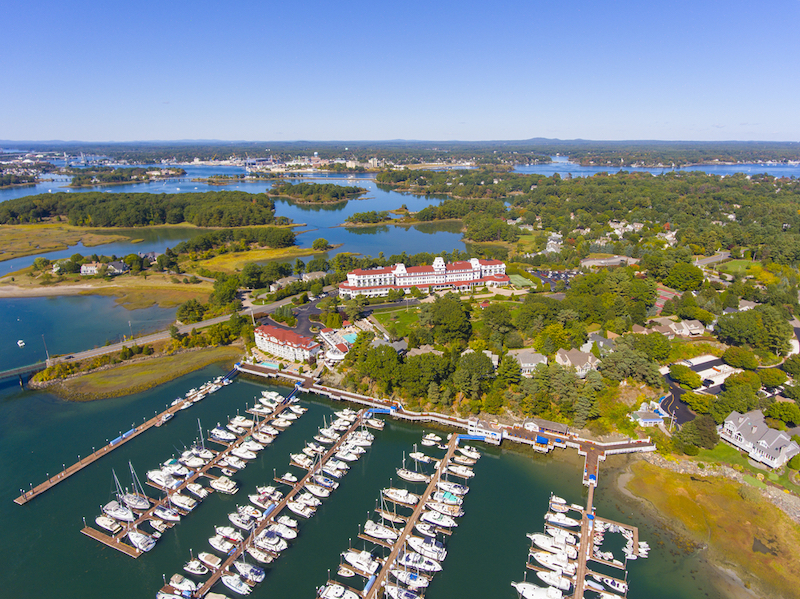
Opened: 1888
Not many hotels in America have seen wars end within their walls, but this seaside resort in the Granite State is the odd one to hold that honor. In 1905, then-President Theodore Roosevelt convened diplomats from Japan and Russia here, resulting in the Portsmouth Peace Treaty and ending the Russo-Japanese War. The affair earned old TR the Nobel Peace Prize and cemented Wentworth’s place in history. Today, the Wentworth flies a Marriott flag, and remains the centerpiece of the island of New Castle, just off Portsmouth.
New Jersey – The Berkeley Oceanfront Hotel, Asbury Park
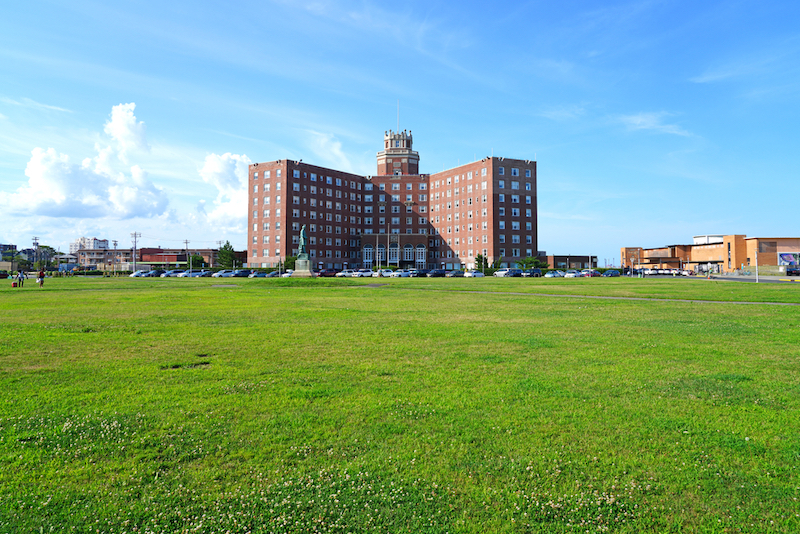
Opened: 1924
Long before Bruce Springsteen made Asbury Park a household name, there was The Berkeley, the shore town’s first large-scale resort and a popular seaside destination. It’s noted for its trademark Beaux Arts turret, set literally across the street from the Stone Pony and just a short walk from the Asbury Park boardwalk. In the past few decades, the surrounding city has rebounded and come back as one of the shore’s top dining and nightlife destinations. The hotel has a tiki bar and sprawling resort pool to match.
New Mexico – La Fonda on the Plaza, Santa Fe
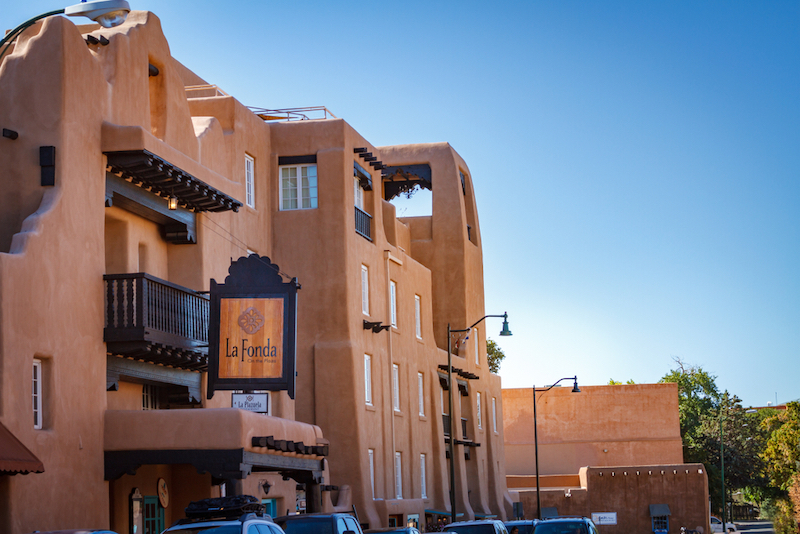
Opened: 1922
People often forget the historical significance of Santa Fe, the third-oldest city in America and site of the nation’s oldest house. It’s also home to the oldest hotel site in America, the intersection of the Santa Fe Trail and East San Francisco Street, where some sort of lodging has stood since 1607. This iteration has been there since 1922, an adobe charmer with dark-wood molding and a fantastic New Mexican restaurant in the atrium. It’s the perfect place to kick back with a lunchtime margarita and revel in the fact that people have been doing nearly the same thing on this exact spot for centuries.
New York – The Plaza, New York City
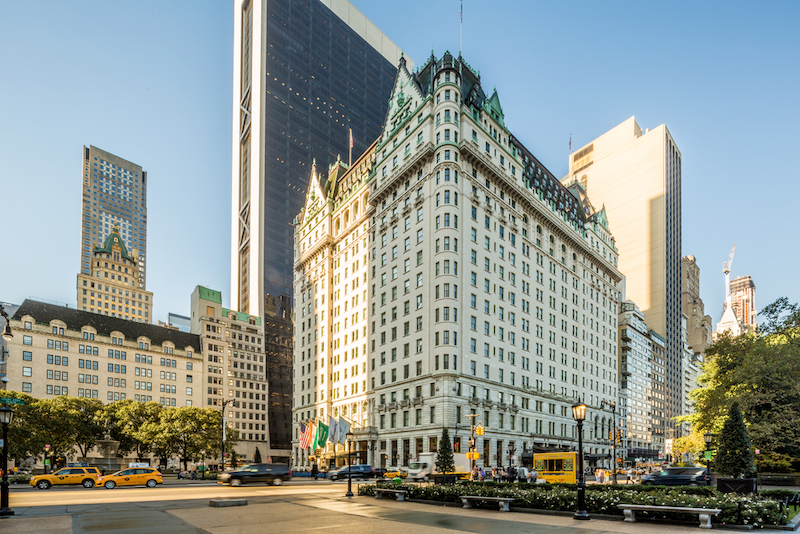
Opened: 1907
The Plaza is the Empire State Building of hotels, the most famous residency in a city that seems to have several on every block. Countless movie scenes have been filmed at this French chateau landmark, from the now-infamous Donald Trump cameo in “Home Alone 2” to Hitchcock’s “North by Northwest” and “The Great Gatsby.” The hotel is synonymous with New York City luxury, and that’ll certainly be your experience should you be lucky enough to stay here. For those of use that aren’t gazillionaires, the Plaza has more-affordable ways to immerse yourself in the property, like the basement-level Todd English food hall with its wealth of fast-casual dining options and food that lives up to the Plaza name.
North Carolina – The Inn on Biltmore Estate, Asheville
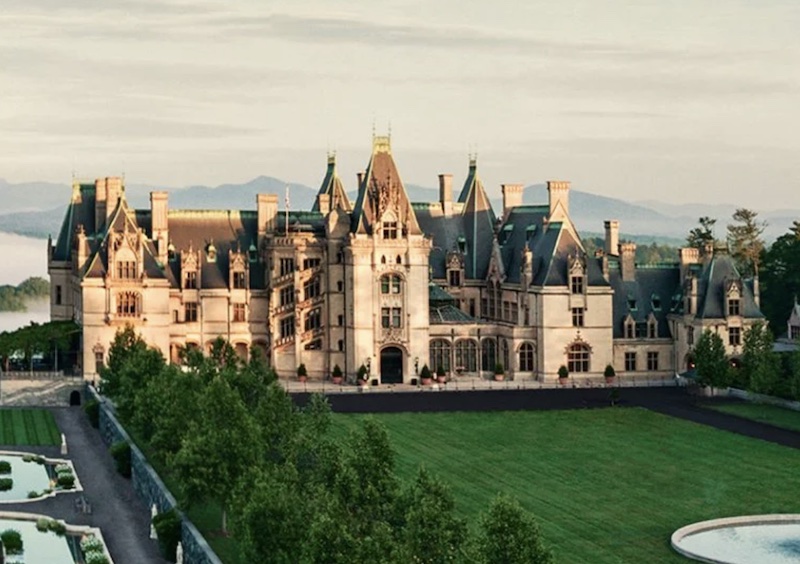
Opened: 2001
Rarely does one get to take a tour of a Gilded Age mansion, much less sleep on a Vanderbilt property. Though you can’t exactly spend the night in George Vanderbilt’s bedroom at the Inn (it exists in a series of buildings separate from the main house), you can get a sense of what guests at the 250-room mansion might have experienced back when the robber baron lorded over the estate. Taste wine at the on-site winery, take horses through the property’s rolling hills, enjoy a multi-course dinner in its fine-dining restaurant and pretend you run the world, even if just for a moment.
North Dakota – Hotel Donaldson, Fargo
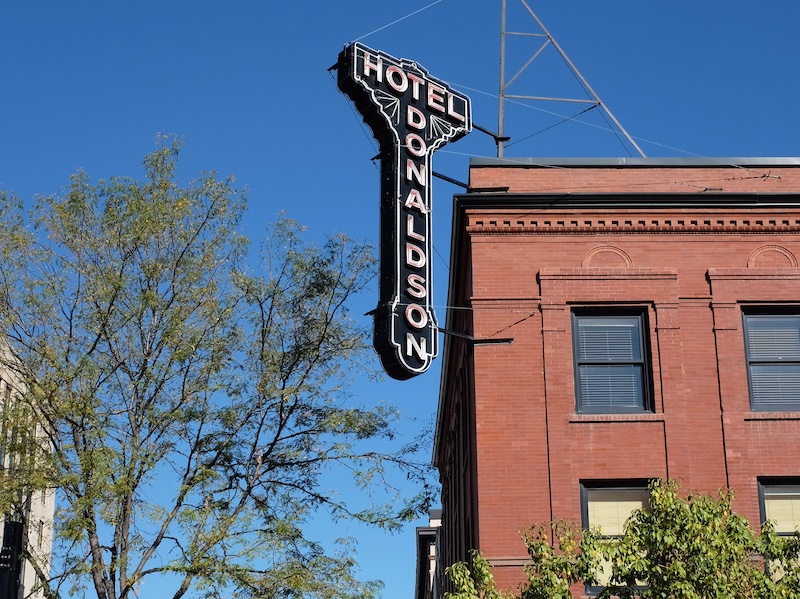
Opened: 1893
Each of this downtown Fargo anchor hotel’s 17 suites were individually designed by different artists, making it one of the coolest hotels for art in the country. Before it was a bastion of creativity in the windswept plains, the Donaldson was the city’s shining symbol of revitalization after downtown burned in 1893. Though it fell on hard times for a while, the Donaldson has come back and turned into a symbol of Fargo’s super-underrated coolness. It may not be far from replacing the wood chipper as the recognizable symbol of the city.
Ohio – Hotel LeVeque, Columbus
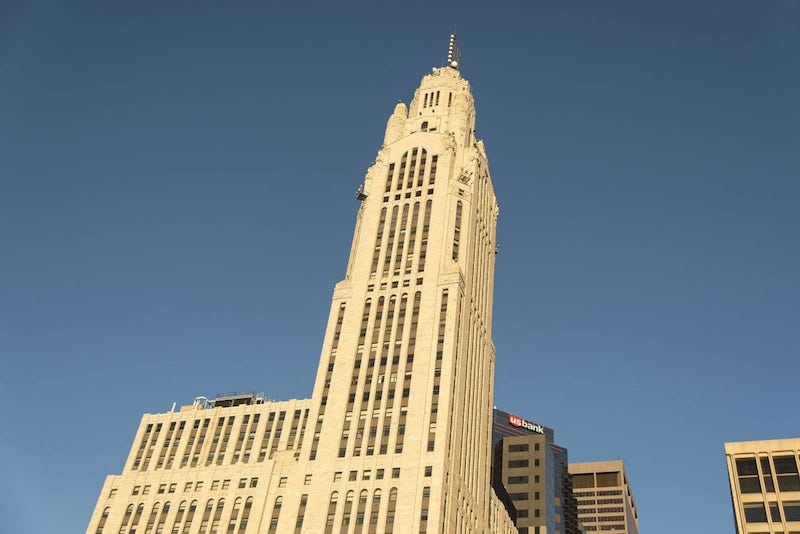
Opened: 1927
Columbus, Ohio, doesn’t exactly have one of America’s most distinguished skylines. Yet, if you can picture one building from Ohio’s largest city that isn’t a football stadium, it’s likely the Art Deco masterpiece that is the LeVeque Tower. When it opened it was the fifth-tallest building in the world, the highest between New York and Chicago, and meant to resemble a lighthouse shining out onto the city. Original frescos, wainscotting and tile work from its heyday still adorn the lobby. The hotel became an Autograph Collection property in 2017, with 149 rooms, six suites and a Modern American bar and restaurant on the lower floors.
Oklahoma – Skirvin Hilton, Oklahoma City
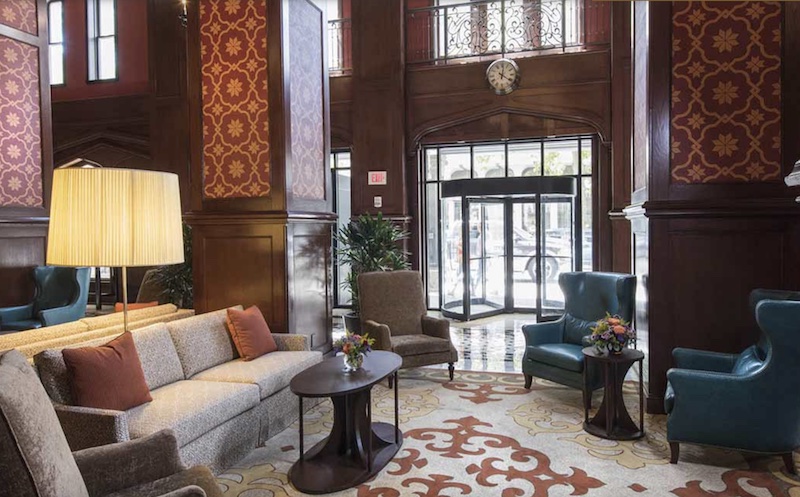
Opened: 1911
Called “Oklahoma City’s most charming hotel,” the Skirvin Hilton is a timeless 225-room hotel and the perfect base camp for all you’d want to hit in OKC. It’s perfectly positioned near the Business District and Bricktown, a previously neglected warehouse district left over from the Great Depression that’s become an entertainment and nightlife hub. If you’d prefer to stay in, though, you can enjoy the Red Piano Lounge, which hosts live music several times a week.
Oregon – Timberline Lodge, Government Camp

Opened: 1955
While the Stanley Hotel gets most of the credit for its role in Stanley Kubrick’s adaptation of “The Shining,” keen-eyed cinephiles will notice the exterior shots were all done at Oregon’s Timberline Lodge. No, there’s no hedge maze anymore, as this spot serves mostly as a ski and snowboard lodge for nearby Mt. Hood, but there are dining rooms with some of the best panoramic views in the state. Once you’re inside sipping on hot cocoa by the titanic stone fireplace, you’ll forget Jack Nicholson once froze to death outside.
Pennsylvania – The Notary Hotel, Philadelphia
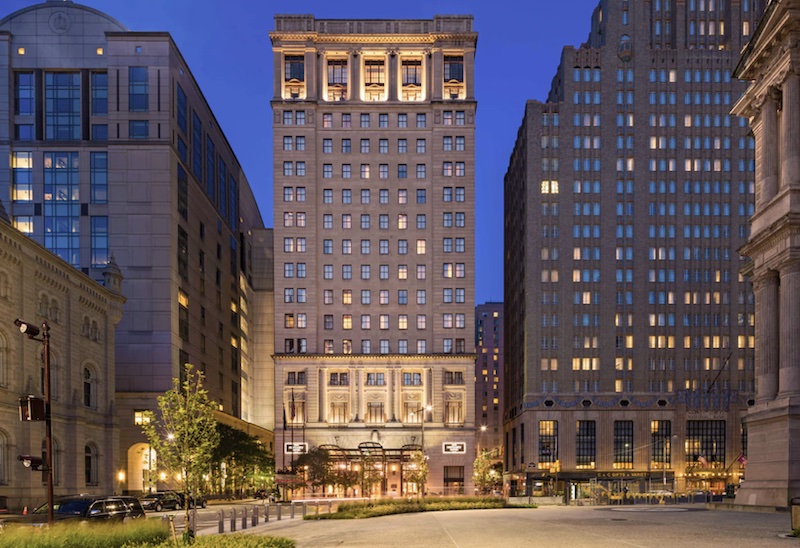
Opened: 1926
The building that was formerly City Hall Annex is now a luxury hotel. Its theme is “stamp of approval,” a nod to its original purpose. You’ll find your guest card stamped with a custom wax seal and can shop at the boutique selling local products that earned the hotel staff’s “stamp of approval.” A lot of the original architecture has been preserved and intermixed with modern touches. The Notary is also steps away from countless museums, the Liberty Bell and Reading Terminal Market, a must-visit indoor farmers market.
Rhode Island – Castle Hill Inn, Newport
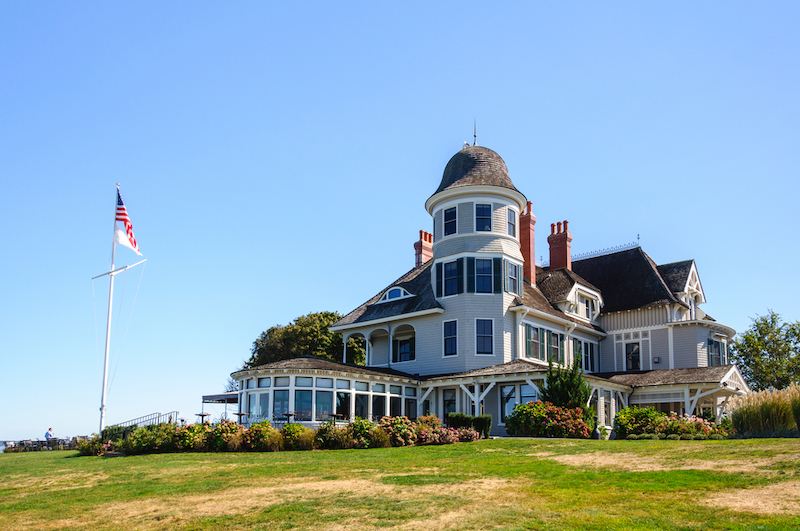
Opened: 1875
Casual, secluded opulence defines this coastal hotel at the west end of Newport’s famous Ocean Drive. Castle Hill Inn sits on a 40-acre peninsula, combining some of the city’s most iconic properties into one majestic resort. It consists of a Victorian mansion and beach cottage rooms with gorgeous views of Narragansett Bay, as well as the Harbor House, which was a beloved hideaway of actress Grace Kelly. Not only did the hotel survive a 1938 hurricane, but it served as an impromptu base for WWII naval officers before being converted into a hotel at war’s end. It’s now the quintessential New England beach vacation spot with all the expected amenities, like seasonal yoga classes, afternoon tea, coastal bicycling and lawn games.
South Carolina – Wentworth Mansion, Charleston
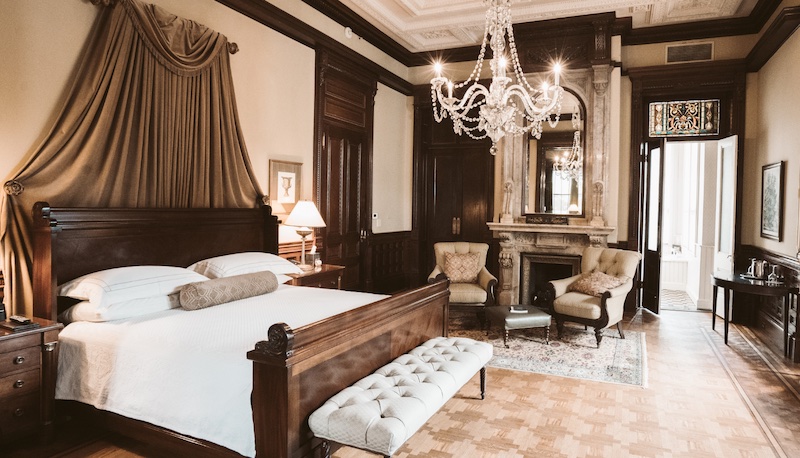
Opened: 1998
One of the top places to stay in a city that often tops must-visit lists, Wentworth Mansion is a nod to Charleston’s gilded age and cotton merchant Francis Silas Rodgers’s 19th-century grandiose wealth. Rodgers designed this as a home for his wife and 13 children, with 14-foot ceilings, Tiffany windows and crystal chandeliers. In our modern times, it also includes a renovated carriage house restaurant, luxurious spa, and cupola rooftop with a stunning city view.
South Dakota – Hotel Alex Johnson, Rapid City
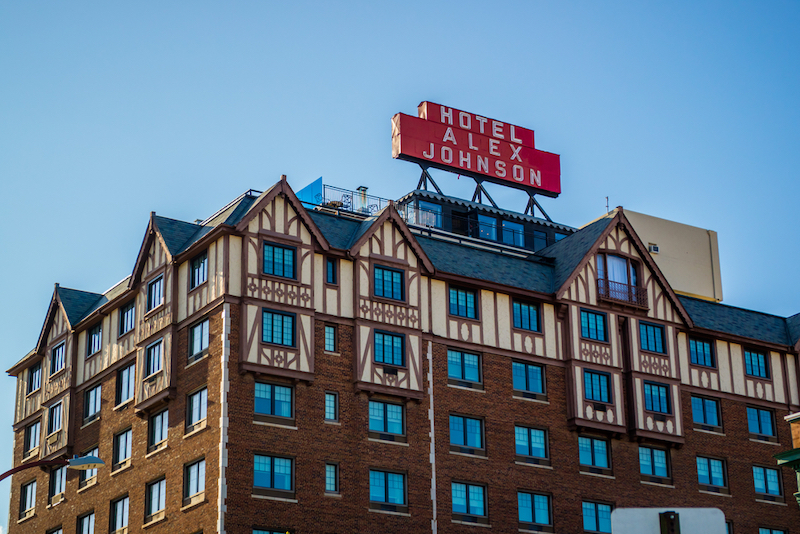
Opened: 1928
While the Alex Johnson has hosted presidents, movie stars and pretty much any person of note who has ever come through Rapid City, its most famous guest was one who was literally dying to get out of there. The fabled Lady in White was a young bride who allegedly committed suicide by flinging herself out of room 812’s window. Guests say the hallway adjacent to this room remains eerily cold and noisy with footsteps, and the hotel understandably claims these stories are nothing more than rumors. While the ghost may be up for debate, we can say for certain that the Alex Johnson has a salon, sweet shoppe and rooftop bar with a panoramic view of the Black Hills. The lobby pays tribute to the Wild West, centered around a massive torch chandelier that gives the Alex Johnson an immediate sense of place.
Tennessee – Peabody, Memphis
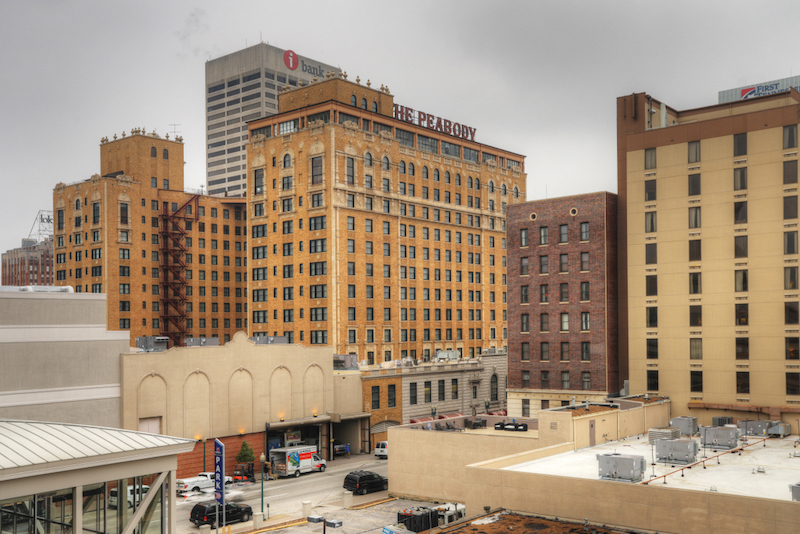
Opened: 1869
Opening just after the Civil War, The Peabody Hotel has long been considered the social and business hub of Memphis. However, it didn’t gain worldwide fame until one evening in 1933, when general manager Frank Shutt returned from a hunting trip with live decoy ducks. Presumably under the influence of Tennessee whiskey, he placed the ducks in the hotel’s lobby fountain. Ever since, mallard ducks have called this lobby home, hanging out in the lobby fountain everyday from 11 a.m. to 5 p.m. They’ve become a Memphis tourist attraction right up there with Graceland and Beale Street.
Texas – Marriott Marquis, Houston
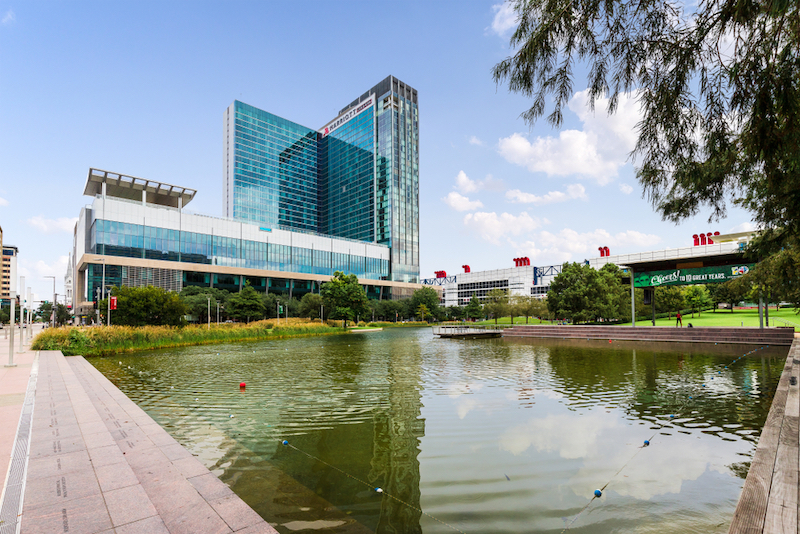
Opened: 2016
Are there older, grander hotels in Texas? Sure. The Driskill in Austin has centuries on this downtown Houston mega-hotel, and the cattle-adorned interior to boot. Yet, when anyone in 2022 pictures a hotel in Texas, odds are the first image that comes to mind is the massive, Texas-shaped lazy river outside the Marriott Marquis in Houston, which might be the most iconic state-themed feature of any hotel in America. Does that make the Marriot Marquis a one-trick pony? Maybe. Still, nothing says Texas like unabashedly repping your state, and if that ain’t iconic then we don’t know what is.
Utah – Grand America, Salt Lake City
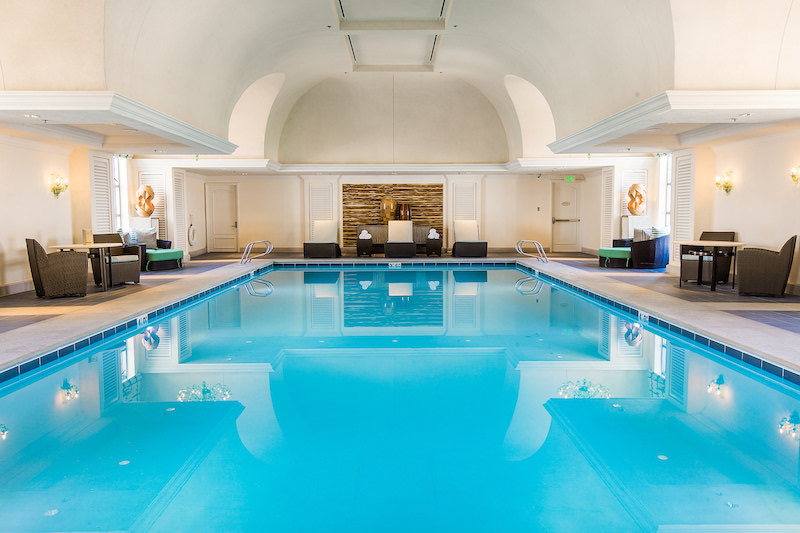
Opened: 2001
One of the youngest hotels on this list, Salt Lake City’s landmark hotel opened for the 2002 Olympics, taking endless inspiration from the Gilded Age hotel palaces of 100 years prior. The interior is a forest of marble, brass and dark wood, complete with a windowless speakeasy and a live music lounge just off the front desk. Rooms are similarly full of furniture one would imagine in a grand hotel of centuries ago, ideal for lounging in while taking in the views of the Wasatch Mountains and downtown Salt Lake City. With 775 rooms and 100,000 square feet of meeting space, it’s also become a regular destination for conventions too. Much like the mega-resorts of yesteryear, this is a place you can meet just about anyone.
Vermont – Middlebury Inn, Middlebury
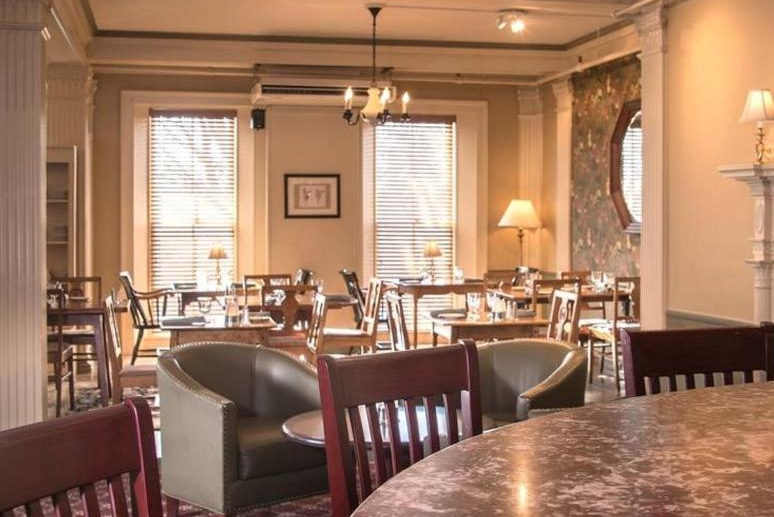
Opened: 1827
The Middlebury Inn has maintained its small-town charm quite well for all the modifications it’s seen. The hotel is the amalgamation of its many owners’ visions, mostly businessmen with vastly different artistic ideas, and gained its most noticeable modernizations in the Roaring Twenties. It resides in the heart of the Champlain Valley, and what amounts to Federal-style architecture complements the mountains nicely. Check out the historic downtown, Otter Creek or Riverfront Park to enjoy Middlebury in the same way it’s been enjoyed for centuries.
Virginia – The Jefferson, Richmond
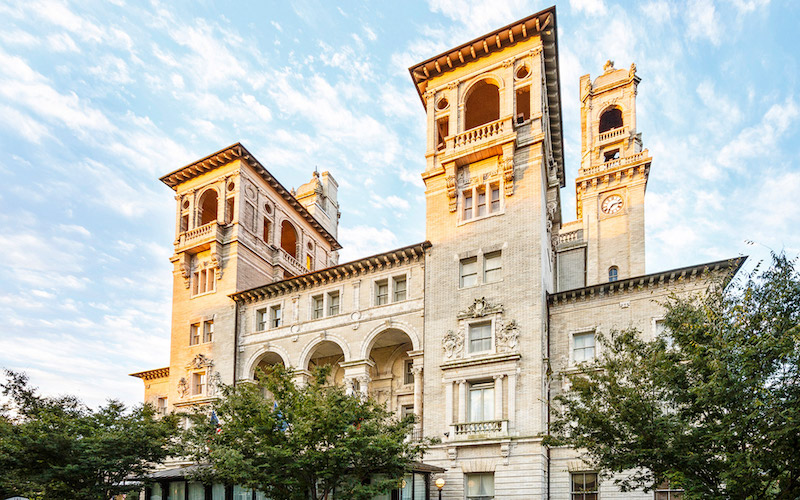
Opened: 1895
Created to be a true constant amid bustling business and social life in Richmond, The Jefferson was local character Lewis Ginter’s tribute to his city back in 1895. After twice losing his fortune and then gaining it back in the tobacco industry, Ginter built the eclectic, Beaux Arts-style hotel that has earned itself a spot on the National Register of Historic Places. It’s been home to 13 presidents, distinguished entertainers like Frank Sinatra and Elvis Presley and, most interestingly, alligators. Yes, for a time these donated pets happily occupied marble pools in the Palm Court. Though it’s been many years since a real reptile has graced The Jefferson, you will find them referenced throughout the hotel’s decor.
Washington – Edgewater, Seattle
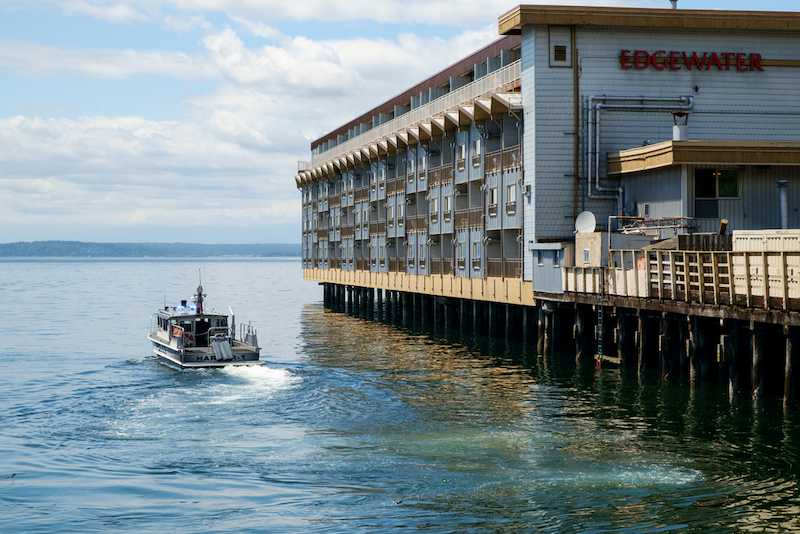
Opened: 1962
There may be no hotel in America more steeped in rock ‘n’ roll lore than The Edgewater, set on the shores of Puget Sound in downtown Seattle. The Beatles took one of their most iconic photos fishing out of one the hotel’s windows in a shot that’s inspired a million Instagram imitations. It’s also the setting of some of Led Zeppelin’s most outrageous stories, including one infamous urban legend involving an adventurous groupie and a fish. Whether or not that fish story actually happened, The Edgewater has gained a reputation as the hotel of choice for everyone from Neil Young to Pearl Jam. It’s an unquestionable icon, even without views of the Olympic Mountains and Elliott Bay.
West Virginia – The Greenbrier, White Sulphur Springs
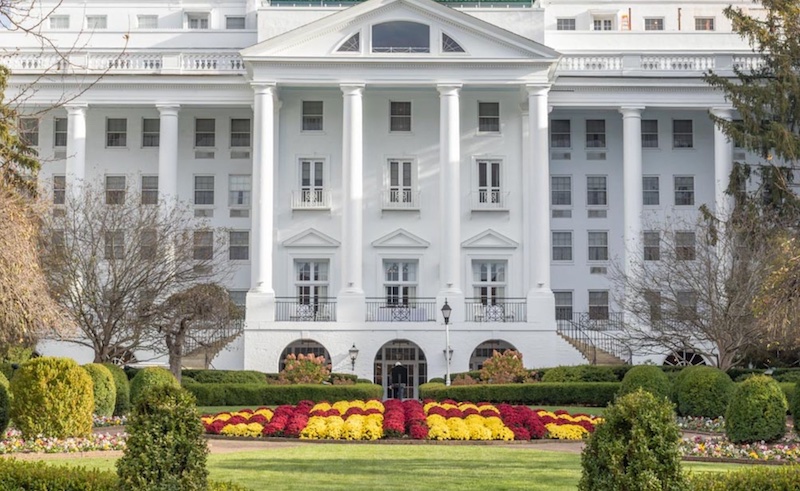
Opened: 1778
The Greenbrier has an intimidating list of clientele ranging from U.S. presidents to international royalty to Hollywood superstars like Judy Garland, Bing Crosby and Grace Kelly. The elite and common alike flock here because of its stunning mountain locale, four PGA golf courses, mineral spa, plentiful shopping and the Prime 44 West steakhouse. It’s also a mainstay for special occasions like weddings or the holidays. Though it might cost more than the GDP of West Virginia to stay here, sometimes it’s worth the splurge.
Wisconsin – The Pfister Hotel, Milwaukee
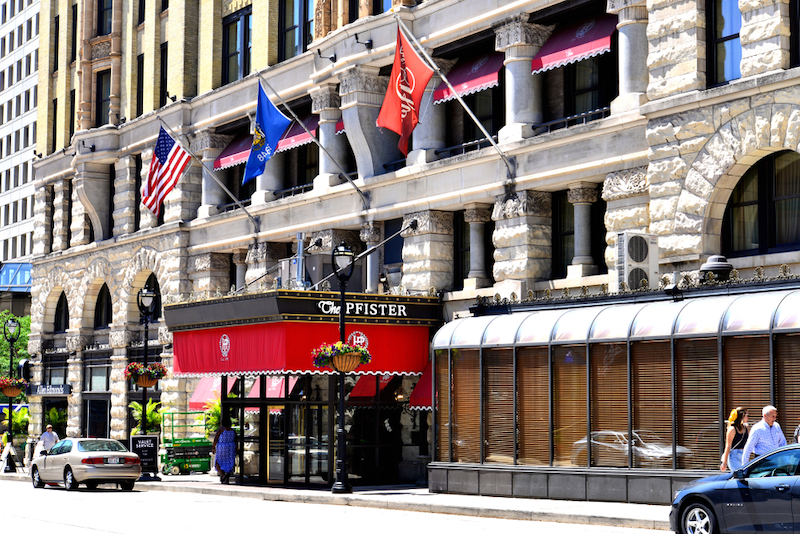
Opened: 1893
This luxury property measures up to what its creator, businessman Guido Pfister, had envisioned for it over a hundred years ago: a grand meeting place that would attract entertainers and dignitaries alike. The Pfister was always gorgeous, even billed as the “Grand Hotel of the West” upon opening in 1893, and a renovation in 1962 added a swanky 23-story guestroom tower. Since then it’s acquired a luxury spa and several newer dining options, but at its heart it remains the same—a sumptuous experience with fine hospitality. Make sure not to miss the guided art tour from the artist in residence. This Milwaukee spot has the biggest Victorian art collection of any hotel.
Wyoming – Old Faithful Inn, Yellowstone
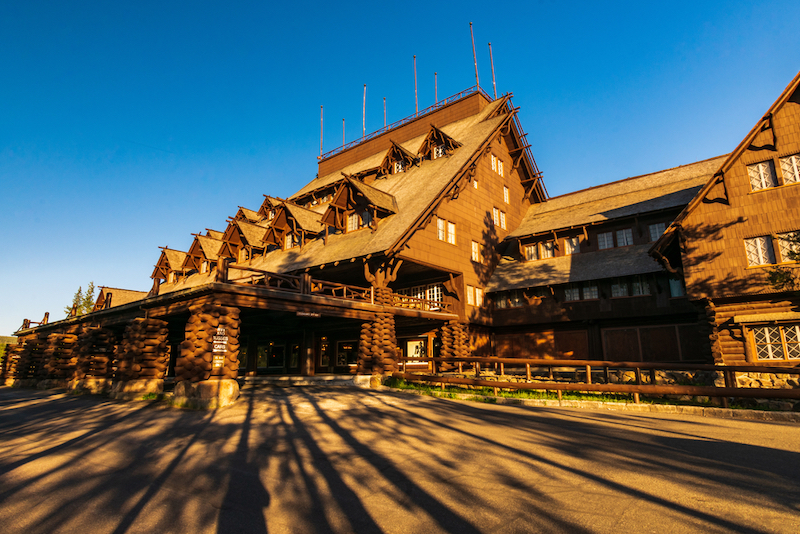
Opened: 1904
The largest log structure in the world sits against the stunning nature of Yellowstone and has a prime view of the Old Faithful geyser for which it’s named. It’s got over 300 Western-themed rooms. When you’re not getting closeups of the geyser to send to your jealous family and friends, you can enjoy the rustic lobby with its focal-point stone fireplace, or enjoy a traditional comfort meal in one of the many dining rooms.


